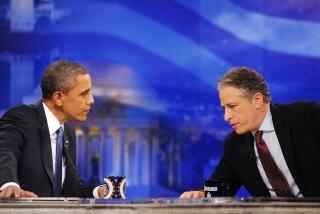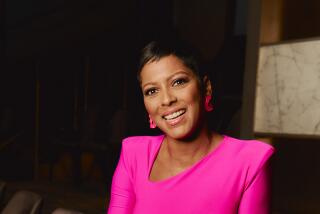After Oprah leaves, daytime TV may never be the same again
Oprah Winfrey, the monarch of daytime television, tapes her final episode this month. For 25 years, Winfrey, avatar of the national psyche and high priestess of the self-empowerment movement, has ruled the daytime airwaves by inviting celebrities and statesmen to her couch for friendly tĂȘte-Ă -tĂȘtes watched by millions of loyal followers.
Already, members of TVâs royalty are plotting to seize Winfreyâs crown. Katie Couric is marshaling an insurgency. Anderson Cooper has staked a beachhead. Judith Sheindlin â a.k.a. âJudge Judyâ â has built her own fortress with more than 6 million daily viewers. Ellen DeGeneres is carving out her niche as the queen of nice.
Thereâs even an opening for a new jester of daytime as Regis Philbin â who has logged more hours in front of the camera than any player in the realm and turns 80 in August â exits âLive With Regis and Kelly.â
It could be years before any of the claimants emerge as Winfreyâs rightful heir â if at all. Daytime television may never again give birth to an ĂŒber-personality like Winfrey. With hundreds of cable channels and thousands of Internet sites vying for peopleâs time, it is becoming ever harder for an individual to command a common audience of shared interests and empathy.
âItâs going to be very difficult, if not impossible, for someone to be as dominant as Oprah has been,â said Bill Carroll, director of programming for Katz Media. âWhen she came on the air, most cities had only two or three TV stations and cable penetration was relatively low. Many channels didnât exist.â
The turnover comes as soap operas â once the chief form of escapism from the tedium of household chores for countless women â are nearly washed up.
When ABCâs âAll My Childrenâ and âOne Life to Liveâ end their runs next season, only four network soaps will remain on the air, compared with nearly a dozen a decade ago. At its peak in 1981, more than 14 million people watched âGeneral Hospitalâ on ABC. Now, fewer than 3 million tune in daily.
Societal and demographic changes are at the heart of daytime TVâs upheaval.
âThere is a transition going on in daytime television, and it is a generational change,â said Ken Werner, president of Warner Bros. domestic television distribution.
A wave of women flooding the workforce has been accompanied by a rise in the popularity of shows featuring women in charge of their lives â and influencing others.
Staple soap opera themes of women in jeopardy or navigating relationships has given way to role models such as Winfrey power brokering presidential candidates on her show, upscale female professionals crossing swords on âThe View,â and litigants submitting to justice dispensed by a stern 68-year-old school-marm-in-a-lace-collar on âJudge Judy.â
âWomen no longer feel that they need to have an escape in their daytime television,â said Brian Frons, president of daytime programming for the Disney ABC Television Group. âThey are looking for information so they can take an active role in changing their lives. Itâs a huge difference from what weâve seen before.â
In that environment, itâs not surprising that personality-driven, issue-oriented programs have stubbornly held on, accounting for the interest of television newsâ big guns Couric and Anderson heading to daytime. Talk shows that delve into topics of the moment, deliver an upbeat message and make their way onto Facebook favorites and Twitter streams â such as ABCâs âThe Viewâ â have even seen their audience level perk up during the current TV season.
Trading the evening for the daytime shift may seem to carry the whiff of going down-market, but it also holds the promise for much greater riches: Talk shows can be a powerful launchpad for a branded media empire as demonstrated by Winfrey, Martha Stewart, Phil McGraw and Rachael Ray who have all developed offshoot ventures, such as magazines, books and merchandise.
Still, in an era when the media business is being radically reshaped, daytime television often looks caught in a time warp. TV programmers have not strayed from the well-worn formats of talk shows, game shows and court shows that were pioneered decades ago. When Winfrey takes her final bow, the new ratings maven of the afternoon will be a onetime family court judge.
Now wrapping up her 15th season, âJudge Judyâ continues to preside from a soundstage on Sunset Boulevard in Hollywood. Sheindlinâs audience in recent years often has eclipsed Winfreyâs and earns her a paycheck of about $43 million annually, according to industry insiders.
âOur core viewing audience has been the baby boomer generation, people who are very loyal to their schedules,â said John Nogawski, president of CBS Television Distribution. âIf they grew up watching Channel 4, they still watch Channel 4.â
But people under 35 arenât as dependable. âThey are more fickle,â Nogawski said. âTheir loyalty â even to the medium of television â isnât as strong.â
Blame the Internet. Some 50 million people are playing social games like Zyngaâs Cityville and CafĂ© World, with those between ages 18 and 24 â the most difficult audience for network advertisers to reach â the heaviest users. More than 102 million women are on Facebook. And the time this crowd spends on the Internet playing games or checking Facebook updates is time away from daytime programs.
Consolidation in the entertainment industry also is leading to less variety on the daytime screen. Five companies now make the bulk of daytime programs and, whereas five or six new shows used to premiere each September, now the number is down to one or two.
âThese days, program syndicators now are all part of big corporations, and they are less willing to take risks,â said Katzâs Carroll.
For TV stations, carrying an afternoon Couric talk show would seem like a reasonable bet after her successful 15-year run as co-anchor of NBCâs âToday.â Couric, 54, appears to be looking for a more comfortable fit after a rocky five-year run on the âCBS Evening News.â
âIt might be nice for me to have a little more wiggle room to show my personality,â Couric said last month on âToday.â
CNNâs Cooper, who turns 44 this summer, also sees a daytime talk show as a platform to stretch his talents.
âThere is a lot of opportunity to do a program that has variety; something that can cover a huge range of topics and become a place to tell interesting and intriguing stories,â Cooper said. âIâm a more multi-dimensional person than a news environment will allow.â
But the days when a successful daytime talk show can turn the host into a billionaire may be over.
TV stations will pay considerably less for a show hosted by veterans Cooper or Couric than what Winfrey has been able to command. Industry executives estimate that Winfreyâs show in recent years has generated more than $260 million annually in revenue, with Winfrey keeping the bulk of the profits.
Once likened to owning a private mint, TV stations in recent years have seen their fortunes fade as they lost audiences and advertisers to cable TV and the Internet. Then came the recession that caused advertisers to cut their budgets. Thatâs forced program syndicators to accept less money for their shows.
Costs were a factor when ABC last month said it was scrubbing two of its three soap operas that each have been on the air for more than 40 years. The cancellations came seven months after consumer products giant Procter & Gamble retired its last soap opera, âAs the World Turns,â on CBS.
For replacements, ABC has lined up two lifestyle shows: âThe Chew,â a one-hour show exploring food trends and healthy eating, and âThe Revolution,â a make-over show featuring fashion expert Tim Gunn.
It followed CBSâ decision to supplant âAs the World Turnsâ with the chat show âThe Talk.â
Talk shows cost about 30% less to make than soap operas, which require crews of 120 people, including actors, writers and technicians, and carry a production budget of about $50 million annually. Four years ago, advertisers spent $911 million to buy commercials in network soap operas, according to Kantar Media, which tracks ad spending. By last year, the amount had dropped to $630 million.
Beyond the economics, talk shows provide a venue to exchange information that is the antithesis of the unilateral narratives of soap operas. Media is no longer a passive experience; opinion and timeliness are the new touchstones for the women who mostly compose the daytime audience.
âThere has been a major cultural and value shift in what women are looking for,â said Dori Molitor, chief executive of WomanWise, a Minnesota-based consulting firm, whose clients include Hasbro, Nabisco and United Healthcare. âThey are in pursuit of more meaning and purpose to their lives, they are reaching out for information on how to achieve their greatest potential.â
More to Read
Sign up for The Wild
Weâll help you find the best places to hike, bike and run, as well as the perfect silent spots for meditation and yoga.
You may occasionally receive promotional content from the Los Angeles Times.











